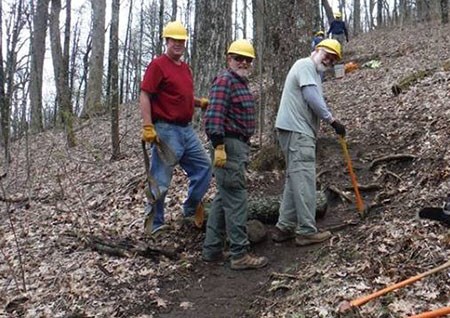Last updated: March 23, 2021
Article
Partnering to Protect the Appalachian Trail

Appalachian Trail Project Office, National Park Service. Accessed at Library of Congress.
The Appalachian Trail, often called the AT, is a continuously marked footpath stretching approximately 2,190 miles across 14 states from Georgia to Maine. The trail travels through eight national forests, six national parks, two national wildlife refuges, and dozens of state forest or park areas. The trail corridor encompasses five major geologic provinces and eight ecological zones, in addition to countless cultural resources that represent the regional character and cultural landscapes of the Appalachian Mountains. The long-distance trail is an impressive and unique resource in itself and a testament to the endless labor of dedicated volunteer networks and partnerships in coordination across the east coast.
Origins of the Trail
The naturalistic designed landscape was conceived of by forester and regional planner Benton MacKaye in 1921 as a wilderness retreat from urban life and as a means of preserving the ridgeline of the Appalachian Mountains. The trail was designed and constructed in the 1920s and 1930s by volunteers of the Appalachian Trail Conference, now called the Appalachian Trail Conservancy (ATC), a non-profit founded in 1925. With the assistance of federal and state agency partners, including efforts by the Civilian Conservation Corps, the AT first opened in 1937.
New York Evening Post, April 07, 1922, Page 9, Provided by New York University
The passing of the National Trail System Act developed the role of the ATC, which continues to coordinate trail maintenance and acts as a voice for environmental stewardship and advocacy. Since its inception in the 1920s, the ATC has sought to preserve and manage the trail, “ensuring that its vast natural beauty and priceless cultural heritage can be shared and enjoyed today, tomorrow, and for centuries to come.”
The ATC and the National Park Service
Partnerships and volunteer networks are essential to successfully coordinate the maintenance and management of the vast and diverse land area of the Appalachian National Scenic Trail. The ATC partners with the National Park Service (NPS) and the U.S. Forest Service at national, regional, and district levels, in addition to other private and public agencies, while also working closely with trail maintaining clubs and local communities that span the East Coast.The ATC is comprised of a 15-member Board of Directors and a staff of approximately 55. The non-profit serves as the membership organization to its approximately 36,000 members and coordinates the efforts of 31 affiliated trail clubs. Trail clubs and members average close to 200,000 hours of labor associated with maintaining the AT, at an estimated value of $5,000,000 annually.
Trail Management Resources from ATC
Partners in StewardshipBoth based in Harpers Ferry, West Virginia, the National Park Service’s Appalachian Trail Park Office (APPA) works with the ATC in the protection and management of the trail. While the ATC is responsible for most land-management and maintenance responsibilities, APPA manages land acquisition and surveys, permitting processes, compliance with resource protection laws, law enforcement, and other administrative duties. Thus, with its many moving parts, the trail continues to be maintained and developed by volunteers under the leadership of ATC in cooperation with their agency partners.
In addition to providing recreational opportunities, the 270,000 acre Appalachian Trail corridor also protects the surrounding resources. Challenges to resource management include gathering documentation and monitoring resources across a vast area. This information allows for the ATC and NPS to manage the resources appropriately for future generations. In 2008, the NPS completed the Appalachian National Scenic Trail Resource Management Plan, which outlines the management of natural and cultural resources, the footpath itself, and associated trail facilities including 260 trail shelters. The plan sets priorities for management, monitoring, and research. The resource management plan is one of many guiding documents and agreements that outlines policies for land protection and management between partners and defines the responsibilities for varying actors, including the ATC, the trail clubs, and agency partners.
Source: NPS DataStore Collection 7649 (results presented are a subset). To search for additional information, visit the NPS DataStore.
The Value of Partnerships

Courtesy of Georgia Appalachian Trail Club
The maintenance, management, and protection of this two thousand-plus mile long unit of the National Park Service is only possible through the extensive coordination of public-private partnerships. The stewardship of land and resources on such a grand scale is an exceptional example of what can be accomplished between agencies and organized groups of passionate volunteers with the common goal of protecting a unique, diverse resource. The Appalachian Trail Management Principles suitably states that, “the body of the Trail is provided by the lands it traverses, and its soul is the living stewardship of the volunteers and workers of the Appalachian Trail community.”


